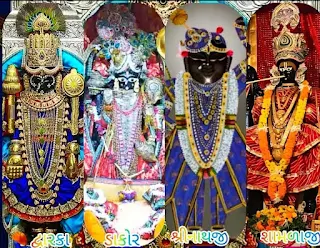May be a repeat.
mAdhava mAmava dEva krSNa
yAdava krSNa yadukula krSNa
anupallavi
sAdhu janAdhAra sarvabhAva
caraNam 1
ambuja lOcana kambu shubha grIva
bimbAdhara candra bimbAnana
cAmpEya nAsAgra lagna sumauktika
shArada candra janita madana
caraNam 2
Agama giri shikharOdita satya
chidadvaya lakSaNa sukha bhAnO
bhOgi kuLOttama bhOga shayana dugdha-
sAgarajA lakSaNAdhya tanO
caraNam 3
indirayA saha sundara krSNa
purandarAdi vandya padakamala
nandanandana yOgivarya dhurandhara
nArAyaNa tIrtha mativihAr
Meaning:
pallavi
mAdhava - O husband of Lakshmi (mA) !
mAmava - Protect me.
dEva krSNa - O Lord Krishna !
yAdava krSNa yadukula krSNa - O Scion of the Yadu dynasty !
anupallavi
sAdhu janAdhAra - O Support of good people !
sarvabhAva - O Embodiment of all creation !
caraNam 1
ambuja lOcana - O Lotus-eyed one !
kambu shubha grIva - O One with an auspicious conch-like neck !
bimbAdhara - O One with (red) lips like a bimba fruit (kovvai pazham)!
candra bimbAnana - O One whose face is like the orb of the moon !
lagna sumauktika - O One with a nice pearl fixed
cAmpEya nAsAgra - at the tip of the nose that resembles the Champaka flower !
shArada candra - O One (pleasing) like the autumnal moon !
janita madana - O Father of Manmatha !
caraNam 2
bhAnO - O Sun
Agama giri shikhara udita - rising atop the hill of the Vedas,
satya chidadvaya lakSaNa sukha - embodying existence, awareness and bliss that is your singular definition !
bhOgi kuLOttama bhOga shayana - O One reclining on the hood of the best of serpents !
dugdha- sAgarajA lakSaNAdhya tanO - O One whose body is endowed with the mark (residence) of Lakshmi, the daughter of the Milk Ocean !
caraNam 3
sundara krSNa - O Handsome Krishna (who is)
indirayA saha - along with Lakshmi !
purandaraadi vandya padakamala - O One whose lotus-feet are saluted by Indra and other Devas !
nandanandana - O Child of Nanda !
yOgivarya dhurandhara - O Foremost among the best of Yogis !
nArAyaNa tIrtha mativihAra - O One sporting in the mind of Narayana Teertha !



























